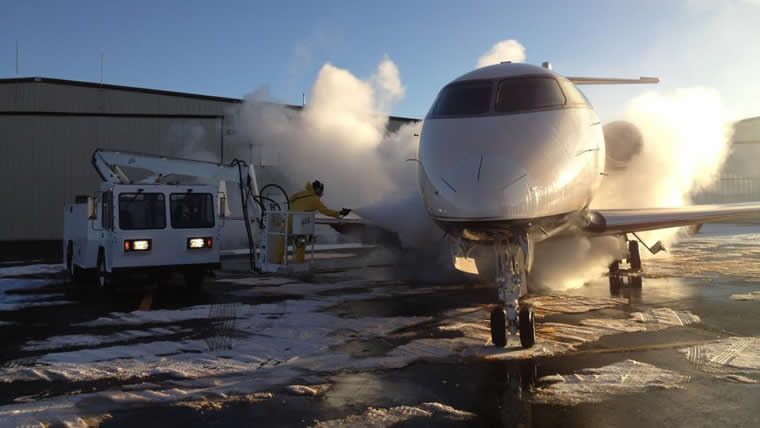Removing ice on the wings is an essential action to ensure flight safety, as its presence can compromise the aerodynamic properties of the aircraft, making takeoff unsafe. In this article we will explain the importance of private jet wing de-icing operations. These procedures are part of safety protocols for private and commercial flights, and are required prior to takeoff in bad weather conditions.
Ice formation on the wings of private jets
Ice can form on the external surfaces of a private jet when it is on the ground or during takeoff in adverse weather conditions.
If the temperature drops below freezing, in fact, moisture in the air tends to freeze on contact with the surfaces of the aircraft, creating a thin but problematic layer of ice.
This phenomenon is common when the plane is parked outdoors overnight at airports located in regions with cold and humid climates. ( e.g. Oslo, Copenhagen, Edinburgh, Vienna, Venice). The simplest and most effective solution to prevent icing would be to park the private jet inside a heated or enclosed hangar.
It would prevent the plane’s exposure to the elements by keeping the surfaces dry.
Alternatively, some private jet operators use protective covers for the wings and engines when the aircraft is parked outdoors in the cold.
These covers should prevent the accumulation of snow and ice on critical aircraft surfaces, but they are not always sufficient.
Dangers of ice on the wings and tail of private jets
The ice layer increases drag by reducing proper airflow that allows the plane to gain altitude and maintain control.
In addition, the extra weight can create additional problems.
If ice is not properly removed from the wings and tail, it could seriously affect the performance of your private jet, especially during a critical time of flight such as the takeoff phase.
Wing de-icing before departure
Before takeoff, the aircraft is inspected for ice, snow or frost.
If necessary, de-icing and ice prevention operations are initiated on the wings. 1) Wing de-icing before takeoff.
If ice is detected, the de-icing procedure using Type I heated glycol-based fluids will be initiated to maximize its effectiveness.
This is sprayed directly onto the aircraft to melt the ice and prevent further accumulation in the immediate area.
The glycol-based compound should be applied to aircraft parts just before departure since its protection is temporary. 2) Anti-icing treatment.
After de-icing, a Type II or Type IV (thicker) anti-icing fluid is applied, which forms a protective barrier to prevent the formation of new ice during takeoff.
These fluids remain on the surfaces until the aircraft’s speed is sufficient for them to slide off without compromising aerodynamics. 3) Final check before takeoff. Upon completion of the de-icing of private jet wings and de-icing treatments on the external surfaces of the aircraft, your private jet pilot and ground crew perform a final check to ensure that the aircraft is completely clean and that the de-icing fluid is effectively protecting them.
Timing for private jet wing de-icing and holdover time
Generally, de-icing the wings of private jets takes 15-30 minutes, while the anti-icing process is faster and takes, on average, 5-10 minutes. However, these interventions can take varying amounts of time depending on several factors, including weather conditions, the amount of accumulated ice, the size of the private jet, and the availability of personnel and equipment on the ground.
For example, smaller private jets (such as Cessna Citation CJ3s or Mustangs) require less time de-icing than larger aircraft. Holdover Time. After anti-icing fluid is applied, there is a period called dwell time, which indicates the time within which the aircraft must take off before the fluid loses its effectiveness.
This varies according to weather conditions and the type of fluid used (usually 20 to 40 minutes). If the plane fails to take off within the dwell time due to traffic or other unforeseen circumstances, it will be necessary to repeat the de-icing procedures, causing further delays.
Delays in private jet departures for wing de-icing operations
It is important to schedule wing de-icing and de-icing treatment in advance, especially at crowded airports or during severe weather conditions.
In fact, these operations can cause delays in departure, especially in particularly bad weather situations, when there may also be other aircraft waiting and you will have to wait your turn. At airports dedicated to general aviation, with adequate de-icing services, waits are shorter.
The ability to shelter private jets in heated hangars also reduces the formation of ice on the surface of aircraft.
Private jet operators try to minimize these delays by managing operations efficiently and often with priority to ensure a quick departure within the dwell times.
Contact PrivateJetFinder to find out the cost of wing de-icing and de-icing treatments.
De-icing private jet wings is done by specialized firms or airport ground staff.
These interventions are additional expenses, usually borne by the charterer. Costs depend on the amount of fluid used and airport rates, usually varying between a few hundred to several thousand euros depending on the size of the aircraft and weather conditions.
As for private jet rentals, detailed information on prices and how to pay for wing de-icing and de-icing treatments will be provided directly by PrivateJetFinder during the quote phase.
Foto ok3.aero/


